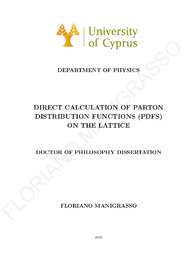Direct calculation of parton distribution functions (PDFs) on the lattice

View/
Date
2022-04Publisher
Πανεπιστήμιο Κύπρου, Σχολή Θετικών και Εφαρμοσμένων Επιστημών / University of Cyprus, Faculty of Pure and Applied SciencesPlace of publication
CyprusGoogle Scholar check
Keyword(s):
Metadata
Show full item recordAbstract
In this work, we address a number of crucial steps in order to evaluate the nucleon unpolarized helicity and transversity parton distribution functions within the framework of lattice QCD. Discretization artifacts are investigated using a $N_f=2+1+1$ gauge ensemble of Wilson twisted mass fermions simulated at a pion mass of approximately $M_\pi=370$~MeV. The unpolarized and helicity parton distribution functions show a non-negligible dependence on the lattice spacing, with the continuum extrapolation producing a better agreement with phenomenology.
The direct computation of the Fourier transform using discrete lattice data may introduce artifacts and we, therefore, use a new data-driven method based on Gaussian process regression, the so-called Bayes-Gauss Fourier transform to overcome the limitations of the discrete Fourier transform. We find that this data-driven approach can drastically reduce the artifacts introduced by the discretization of the Fourier transform, however, the final effect on the light-cone PDFs is small. This finding suggests that the deviations seen between the current lattice QCD results and phenomenological determinations cannot be attributed solely to the discretization of the Fourier transform.
Furthermore, we present results of the first ab initio calculation of the individual up, down, and strange unpolarized, helicity and transversity parton distribution functions for the proton. The analysis is performed on an $N_f=2+1+1$ twisted mass clover-improved fermion ensemble simulated at a pion mass of $260$~MeV. We employ the hierarchical probing algorithm to evaluate the disconnected quark loops, allowing us to obtain non-zero results for the disconnected isoscalar contribution and the strange quark matrix elements. In particular, the results for the strange quark distributions, which are poorly constrained from global fit analysis, provide valuable information on the structure of the nucleon.
Collections
Cite as
The following license files are associated with this item:

